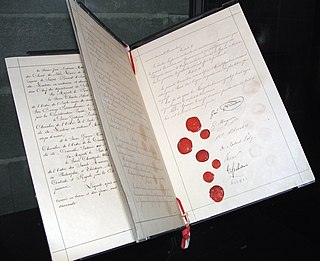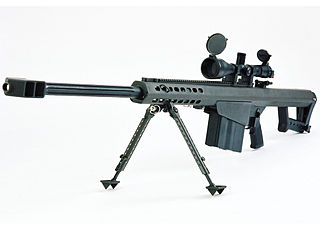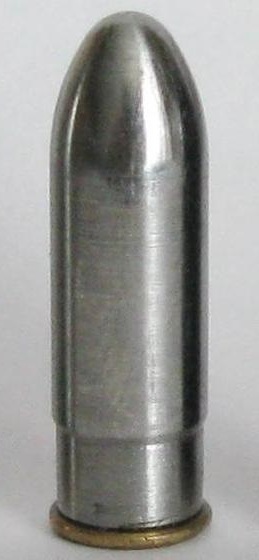
A bullet is a kinetic projectile, a component of firearm ammunition that is shot from a gun barrel. They are made of a variety of materials, such as copper, lead, steel, polymer, rubber and even wax; and are made in various shapes and constructions, including specialized functions such as hunting, target shooting, training, and combat. Bullets are often tapered, making them more aerodynamic. Bullet size is expressed by weight and diameter in both imperial and metric measurement systems. Bullets do not normally contain explosives but strike or damage the intended target by transferring kinetic energy upon impact and penetration.

A full metal jacket (FMJ) bullet is a small-arms projectile consisting of a soft core encased in an outer shell ("jacket") of harder metal, such as gilding metal, cupronickel, or, less commonly, a steel alloy. A bullet jacket usually allows higher muzzle velocities than bare lead without depositing significant amounts of metal in the bore. It also prevents damage to bores from hard steel or armor-piercing core materials.

A hollow-point bullet is a type of expanding bullet which expands on impact, causing a more lethal hit without penetrating further than necessary.

The law of war is the component of international law that regulates the conditions for initiating war and the conduct of warring parties. Laws of war define sovereignty and nationhood, states and territories, occupation, and other critical terms of law.

Terminal ballistics is a sub-field of ballistics concerned with the behavior and effects of a projectile when it hits and transfers its energy to a target.

Expanding bullets, also known colloquially as dumdum bullets, are projectiles designed to expand on impact. This causes the bullet to increase in diameter, to combat over-penetration and produce a larger wound, thus dealing more damage to a living target. For this reason, they are used for hunting and by most police departments, but are generally prohibited for use in war. Two typical designs are the hollow-point bullet and the soft-point bullet.

A shell, in a military context, is a projectile whose payload contains an explosive, incendiary, or other chemical filling. Originally it was called a bombshell, but "shell" has come to be unambiguous in a military context. Modern usage sometimes includes large solid kinetic projectiles, which are more properly termed shot. Solid shot may contain a pyrotechnic compound if a tracer or spotting charge is used.

The Hague Conventions of 1899 and 1907 are a series of international treaties and declarations negotiated at two international peace conferences at The Hague in the Netherlands. Along with the Geneva Conventions, the Hague Conventions were among the first formal statements of the laws of war and war crimes in the body of secular international law. A third conference was planned for 1914 and later rescheduled for 1915, but it did not take place because of the start of World War I.

An anti-personnel weapon is a weapon primarily used to maim or kill infantry and other personnel not behind armor, as opposed to attacking structures or vehicles, or hunting game. The development of defensive fortification and combat vehicles gave rise to weapons designed specifically to attack them, and thus a need to distinguish between those systems and ones intended to attack people. For instance, an anti-personnel landmine will explode into small and sharp splinters that tear flesh but have little effect on metal surfaces, while anti-tank mines have considerably different design, using much more explosive power to effect damage to armored fighting vehicles, or use explosively formed penetrators to punch through armor plating.

An anti-materiel rifle (AMR) is a rifle designed for use against military equipment, structures, and other hardware (materiel) targets. Anti-materiel rifles are chambered in significantly larger calibers than conventional rifles and are employed to eliminate equipment such as engines and unarmored or lightly armored targets. While modern armored vehicles are resistant to anti-materiel rifles, the extended range and penetration still has many modern applications. While not intended for use against human targets, the bullet weight and velocity of anti-materiel rifles gives them exceptional long-range capability even when compared with designated sniper rifles. Anti-materiel rifles are made in both bolt-action as well as semi-automatic designs.

Caseless ammunition (CL), or rather caseless cartridge, is a configuration of weapon-cartridge that eliminates the cartridge case that typically holds the primer, propellant and projectile together as a unit. Instead, the propellant and primer are fitted to the projectile in another way so that a cartridge case is not needed, for example inside or outside the projectile depending on configuration.

Armour with two or more plates spaced a distance apart falls under the category of spaced armour. Spaced armour can be sloped or unsloped. When sloped, it reduces the penetrating power of bullets and solid shot, as after penetrating each plate projectiles tend to tumble, deflect, deform, or disintegrate; spaced armour that is not sloped is generally designed to provide protection from explosive projectiles, which detonate before reaching the primary armour. Spaced armour is used on military vehicles such as tanks and combat bulldozers. In a less common application, it is used in some spacecraft that use Whipple shields.

The Raufoss Mk 211 is a .50 BMG multi-purpose anti-materiel high-explosive incendiary/armor-piercing ammunition projectile produced by Nammo under the model name NM140 MP. It is commonly referred to as multipurpose or Raufoss, meaning red waterfall in Norwegian. This refers to Nammo's precursor company Raufoss Ammunisjonsfabrikker, an ammunition manufacturer established 1896 in Raufoss, Norway. The "Mk 211" name comes from the nomenclature Mk 211 Mod 0 used by the U.S. military for this round.
Military necessity, along with distinction, and proportionality, are three important principles of international humanitarian law governing the legal use of force in an armed conflict.
Air warfare must comply with laws and customs of war, including international humanitarian law by protecting the victims of the conflict and refraining from attacks on protected persons.

The QF 1 pounder, universally known as the pom-pom due to the sound of its discharge, was a 37 mm British autocannon, the first of its type in the world. It was used by several countries initially as an infantry gun and later as a light anti-aircraft gun.

Ammunition is the material fired, scattered, dropped, or detonated from any weapon or weapon system. Ammunition is both expendable weapons and the component parts of other weapons that create the effect on a target.
The Convention of Saint Petersburg may refer to several diplomatic agreements including

An explosive weapon is a weapon that uses high explosive to project blast and/or fragmentation from a point of detonation.
In firearms and artillery, the primer is the chemical and/or device responsible for initiating the propellant combustion that will propel the projectiles out of the gun barrel.
















